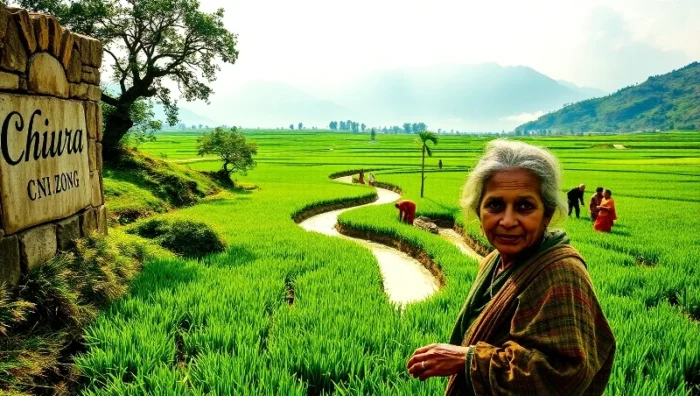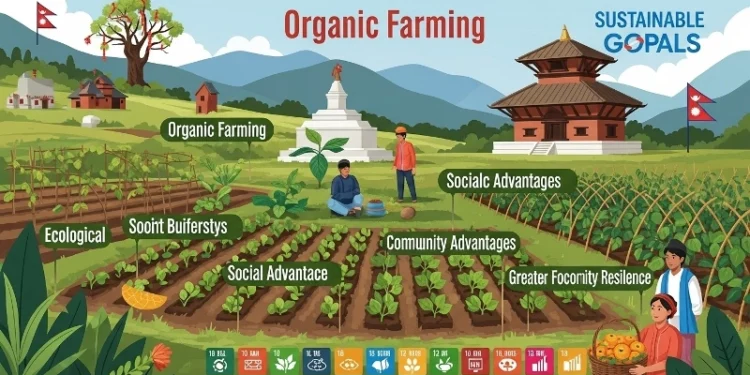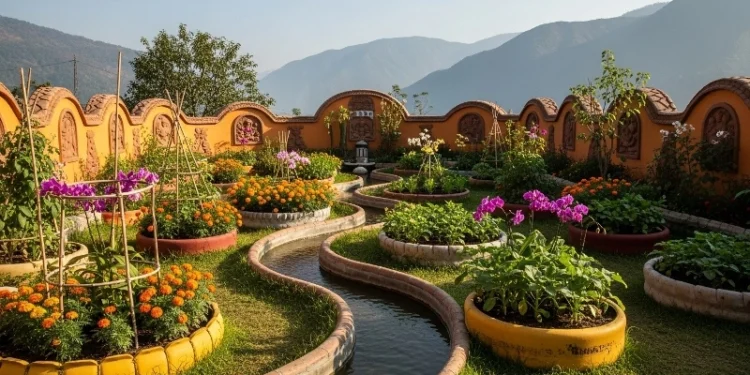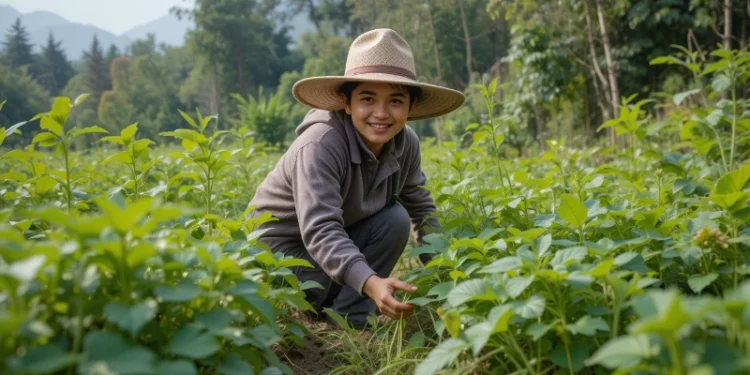Nepal’s lush landscapes, terraced hills, and fertile plains have fed its people for centuries. At the heart of this agricultural abundance lies an intricate relationship between fields, irrigation, and one of the most cherished food items in Nepali culture — Chiura*(flattened rice). This story connects nature, hard work, traditional wisdom, and cultural identity in a seamless flow.

In this blog post, we will explore the journey of rice from fields to plates, the critical role of irrigation in agriculture, and how Chiura symbolizes much more than just food for Nepalis. Join me as we uncover the fascinating story behind these elements that shape Nepal’s rural life and cultural heritage.
Table of Contents
1. The Importance of Fields in Nepal’s Agriculture
Nepal is predominantly an agricultural country. Around 65-70% of its population depends on farming for their livelihood. The fields where crops grow — especially rice paddies — are not just patches of land but the foundation of life, culture, and economy.
Rice is the staple food for most Nepalis, and fields where paddy grows hold a special place in hearts and traditions.
Terraced Fields: Farming on Hills
Because of Nepal’s mountainous terrain, farmers have developed terraced fields on hillsides. These terraces are man-made steps cut into the slopes to create flat areas for planting.
Terracing helps control soil erosion, conserves water, and maximizes land use. It is a testament to human ingenuity and adaptation.
Fertile Plains: The Terai Region
In contrast, the Terai plains in southern Nepal have vast, fertile lands ideal for rice and other crops. These plains are the country’s breadbasket.
Together, hills and plains create a diverse agricultural landscape that sustains the nation.
2. Understanding Irrigation: The Lifeline of Fields
Irrigation refers to the artificial supply of water to land or crops to help growth. In Nepal’s context, irrigation is vital because rice and many other crops require significant water.
Traditional Irrigation Methods
Historically, Nepali farmers developed creative ways to irrigate their fields:
Canals and Channels:Diverting water from rivers or streams to fields through dug channels. Ghamela and Kulo:Local water management systems that use small streams.
Water Wheels:Devices powered by flowing water to lift water to higher terraces. Rainwater Harvesting:Collecting and storing rainwater in ponds or tanks.
Challenges in Irrigation
Irrigation in Nepal faces challenges such as:
Uneven rainfall distribution.
Difficult mountainous terrain.
Seasonal water scarcity.
Infrastructure limitations.
Despite these challenges, irrigation remains central to ensuring good crop yields.
3. Rice Cultivation: From Seed to Harvest
Rice cultivation is a complex and labor-intensive process. It takes months of care, timing, and coordination to grow the rice that eventually becomes Chiura.
Preparation of Fields
Farmers prepare the fields by plowing and leveling the soil, ensuring it can hold water.
Sowing and Transplanting
Seeds are sown in nursery beds and then transplanted to the main fields after seedlings grow.
Water Management
Fields are flooded and drained at different stages for optimal growth.
Weed Control and Fertilization
Regular weeding and organic or chemical fertilizers help protect and nourish crops.
Harvesting
When the rice grains mature, farmers harvest the crop, often using sickles and traditional methods.
The entire process depends heavily on irrigation, weather, and hard labor.
4. The Journey of Chiura: From Paddy to Flattened Rice
Chiura, or flattened rice, is a beloved Nepali food made from rice. Its journey starts in the fields where rice grows and ends on the tables of families celebrating culture and tradition.
Harvesting Paddy
After the rice is harvested, it undergoes several steps to become Chiura:
- Threshing:*Separating rice grains from stalks.
- Winnowing:*Removing husks and unwanted material.
- Parboiling:*Soaking and steaming grains to improve texture and nutrition.
- Drying:*Sun-drying the parboiled grains.
- Pounding:Flattening grains using traditional wooden pounders called Daloor stone grinders.
- Sieving:*Removing broken pieces and impurities.
The result is light, dry flakes — Chiura — ready to be eaten.
5. Cultural Significance of Chiura in Nepal
Chiura is more than food; it is a symbol woven deeply into Nepali culture.
Daily Staple:For many, Chiura is a quick, nutritious meal.
Festivals and Rituals:Chiura features prominently in celebrations like Tihar and Bhai Tika.
Hospitality:Offering Chiura to guests is a sign of respect.
Symbol of Harvest:It represents the fruits of labor and connection to the land.
The sharing of Chiura is sharing tradition and community.
6. Irrigation’s Role in Sustaining Chiura Production
Without proper irrigation, rice fields suffer, and so does the availability of Chiura.
Consistent Water Supply:Essential for growing paddy in both hills and plains.
Increased Yields:Better irrigation leads to more rice and better quality.
Economic Impact:*Farmers with good irrigation have better incomes and can support families.
Investment in irrigation infrastructure benefits the entire agricultural chain, including Chiura production.
7. Traditional Water Management Systems: A Closer Look
Nepal has many ingenious water management systems that support fields and irrigation:
Kulos:Small, gravity-fed canals that distribute mountain water to fields.
Ahar Pynes:Traditional systems from the Terai region for controlling floods and irrigation.
Ponds and Reservoirs:Used to store rainwater during dry months.
Community Cooperation:Water sharing is often managed by local groups, emphasizing social unity.
These systems have been refined over generations and continue to be vital.
8. Modern Challenges and Innovations in Irrigation
With population growth and climate change, irrigation faces new challenges.
Water Scarcity:Erratic monsoons and overuse threaten water supplies.
Infrastructure Needs:Many areas lack modern irrigation canals or pumps.
Soil Degradation:*Poor irrigation management can lead to salinity and erosion.
Innovations:
Drip and Sprinkler Irrigation:Efficient water use in dry areas.
Solar-Powered Pumps:Reducing energy costs for irrigation.
Government Projects:*Investment in irrigation canals and farmer training.
Balancing tradition and innovation is key to sustaining fields and Chiura.
9. The Social and Economic Impact of Rice and Chiura
Rice farming and Chiura production have a deep social and economic impact in Nepal.
Employment:Farming employs millions, supporting families and communities.
Women’s Role:Women play a significant role in rice processing and Chiura making.
Trade and Markets:Chiura is sold locally and even exported, providing income.
Cultural Tourism:Visitors experience traditional farming and food, boosting rural economies.
Supporting rice farmers and Chiura makers means supporting Nepal’s social fabric.
10. Environmental Aspects: Sustainability in Fields and Irrigation
Sustainable farming and irrigation are critical for long-term success.
Organic Farming:Reducing chemical use protects soil and water.
Water Conservation:Efficient irrigation methods reduce waste.
Crop Rotation:Maintaining soil fertility.
Community Management:Protecting shared water resources.
Sustainability ensures that future generations can enjoy fertile fields and delicious Chiura.
11. The Symbolism of Fields, Water, and Chiura in Nepali Folklore
In Nepali stories and songs, fields and water symbolize life, prosperity, and hope.
Chiura appears as a metaphor for simplicity, nourishment, and connection.
Many folk songs praise the rain that feeds the fields and the harvest that fills the home.
These stories keep the cultural spirit alive and remind people of their roots.
12. Celebrations and Festivals Linked to Fields and Chiura
Several festivals in Nepal celebrate agriculture, fields, and food:
Asar 15:Marking the start of the rice planting season.
Tihar:Where Chiura is offered to sisters during Bhai Tika.
Maghe Sankranti:Celebrating new harvests.
Local Harvest Festivals:Villages hold feasts honoring labor and food.
Chiura often features as a highlight, connecting food and festivity.
13. How Climate Change Affects Fields and Irrigation
Climate change brings unpredictable weather, threatening rice fields and water sources.
Erratic Monsoons:Late or heavy rains damage crops.
Droughts:Reduce water availability for irrigation.
Flooding:Can wash away fields and infrastructure.
Farmers adapt through new planting techniques, water management, and diversification.
Climate resilience is essential for continuing the legacy of rice and Chiura.
14. The Future of Rice Farming and Chiura in Nepal
Despite challenges, rice farming and Chiura production continue to evolve.
Youth Engagement:Young farmers adopt new technologies.
Government Support:Policies to improve irrigation and farming.
Market Expansion:Chiura reaches new markets domestically and abroad.
Cultural Revival:Renewed interest in traditional foods and farming.
The story of fields, irrigation, and Chiura is one of perseverance and hope.
15. How You Can Support Nepal’s Agricultural Heritage
Everyone can contribute to preserving this heritage:
Buy locally grown rice and Chiura.
Support fair trade and farmer cooperatives.
Learn and share Nepali agricultural stories.
Promote sustainable farming initiatives.
Celebrate traditional food and festivals.
By valuing these traditions, we honor the people and land that nourish us.
Frequently Asked Questions (FAQs)
What is Chiura?
Chiura is flattened rice, a traditional Nepali food made by pounding parboiled rice grains into thin flakes.
Why is irrigation important for rice farming?
Rice needs consistent water to grow well; irrigation provides a controlled supply, especially during dry periods.
How are terraced fields made?
Terraces are carved into hillsides as flat steps to prevent erosion and retain water for crops.
What traditional methods are used for irrigation in Nepal?
Methods include canals, water wheels, small channels called kulos, and rainwater harvesting.
How is Chiura made from paddy?
Paddy is harvested, threshed, parboiled, dried, then pounded to flatten the grains into Chiura.
What role does Chiura play in Nepali culture?
It is a staple food, used in festivals, rituals, and symbolizes the connection between people and land.
What are some modern irrigation challenges Nepal faces?
Erratic rainfall, water scarcity, lack of infrastructure, and soil degradation.
How can farmers adapt to climate change?
By using drought-resistant crops, improved water management, and changing planting schedules.
What festivals celebrate rice and Chiura?
Asar 15, Tihar (Bhai Tika), Maghe Sankranti, and local harvest festivals.
How can I support Nepali farmers and traditional foods?
Buy local products, promote sustainable agriculture, and celebrate cultural traditions.
Conclusion
The story of Fields, Irrigation, and Chiura*is a beautiful narrative of nature, human effort, culture, and survival. Nepal’s fields tell the story of generations who have worked with the land, the rivers that nourish those fields show the ingenuity of traditional irrigation, and the humble Chiura flakes remind us of the rewards of that labor.
In understanding and appreciating this journey, we connect to a vital part of Nepali identity and heritage. Supporting sustainable agriculture and celebrating traditional foods like Chiura ensures that this story continues for generations to come.






